Your Guide to Basic Rice Know-How
By Alice Osborne
I hang out at health and whole food stores and come away with not just great organic produce at good prices, but loads of very helpful information as well. Our Whole Foods Market, for instance, recently shared great data on rice:
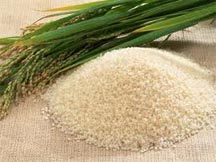 Did you know there are over 7,000 varieties? And what to choose - long grain? Short grain? They have their different purposes. Paella, pilaf, sushi - these and so many other dishes call for different types of rice.
Did you know there are over 7,000 varieties? And what to choose - long grain? Short grain? They have their different purposes. Paella, pilaf, sushi - these and so many other dishes call for different types of rice.
"Long grain" is the generic classification for rice whose milled grains are at least three times as long as they are wide. Common varieties are usually simply labeled "long grain," but you might know them as basmati, Carolina, jasmine or Texmati.
With "medium grain" rice, the grains are less than three times as long as they are wide. Look for bomba, carnaroli, arborio, vialone, Valencia or Thai sticky rice, to name a few.
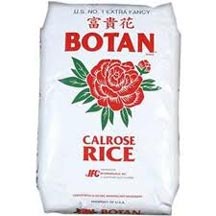 "Short grain" rice indicates grains that are less than twice as long as they are wide. To confuse things a bit, though, medium grain and short grain rice are often combined into this one category, which includes sushi and CalRose rice.
"Short grain" rice indicates grains that are less than twice as long as they are wide. To confuse things a bit, though, medium grain and short grain rice are often combined into this one category, which includes sushi and CalRose rice.
Whole Foods suggests there are a few simple terms we ought to understand that will help us make the right choice when shopping for rice:
• "Polished" rice is white rice that's been polished to remove its bran and germ.
• "Parboiled" rice is the choice if you're wanting fluffy trice. It cooks a bit slower than regular white rice because it's been processed so that the starch in each grain is gelatinized. But this also infuses each kernel with some of the bran's nutrients.
• "Converted rice" is parboiled rice that's been further pre-cooked. Look for this option if you're in a hurry to get supper on the table.
• Whole Foods says that "instant" or "quick" rice, which is processed to cook faster than regular rice, is often lacking in flavor and texture.
• "Brown" rice is considered a healthier choice. Just like whole wheat bread, it's much more nutritious than its white counterpart, in this case because it retains the bran.
• "Wild" rice isn't actually rice at all. In fact, it's the nutty-tasting seed of a long-grain marsh grass. It's great in pilafs (and on its own as a great side dish), so it's included in the Whole Foods list.
Whole Foods Market doesn't just pass along interesting information about food, they share prepping ideas as well, bless their hearts! Here's their no-fail advice on cooking rice:
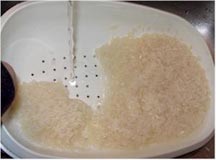 Rinsing: Though modern processing techniques are effective at removing impurities and producing clean, consistent rice, many people still prefer rinsing it before cooking. Proponents say another benefit of rinsing is removing any loose starch, making it less sticky for more consistent cooking.
Rinsing: Though modern processing techniques are effective at removing impurities and producing clean, consistent rice, many people still prefer rinsing it before cooking. Proponents say another benefit of rinsing is removing any loose starch, making it less sticky for more consistent cooking.
Soaking: Some rice (Basmati, for example), cook better after soaking in water to soften the grains for better texture or to prevent breaking of brittle varieties. Most sticky rice won't cook properly without soaking, so if your recipe requires it, do it.
There are 3 methods for cooking rice (who knew?):
Absorption Method: This is the most popular method for cooking rice, using a set amount of rice and a set amount of water for a set amount of time. By the time the water is absorbed, the rice should be done.
 Boiling Method: The rice is cooked much like pasta. The rice is sprinkled into a large pot of boiling salted water then stirred often to prevent sticking or burning. After cooking, be sure to drain it immediately and thoroughly, then rinse quickly in cold water to halt the cooking. (Note: don't try this method with sticky rice.)
Boiling Method: The rice is cooked much like pasta. The rice is sprinkled into a large pot of boiling salted water then stirred often to prevent sticking or burning. After cooking, be sure to drain it immediately and thoroughly, then rinse quickly in cold water to halt the cooking. (Note: don't try this method with sticky rice.)
The Whole Foods folks are actually cooking pros, and don't hesitate to share things they've learned over time:
• If the uncooked rice in the pot is more than two inches deep, choose a larger pot.
• Use a tight-fitting lid so the steam will stay in the pot while the rice cooks.
• When preparing large quantities of rice, consider cooking it in two or three smaller batches.
• Oddly enough, microwaving rice takes no less time than cooking on the stovetop.
Whole Foods also has advice on how to store rice safely - good things to know because weevil just LOVE dry rice! (grrrrr.)
 Uncooked Rice: Due to its low moisture content, properly stored rice should keep without losing quality for as long as 1 to 3 years. Store in a sealed container in a dry, dark, and cool place. (Note: Due to the bran, the shelf life of brown rice is only 1 to 6 months. But if it's stored in the refrigerator or freezer it will last a bit longer.)
Uncooked Rice: Due to its low moisture content, properly stored rice should keep without losing quality for as long as 1 to 3 years. Store in a sealed container in a dry, dark, and cool place. (Note: Due to the bran, the shelf life of brown rice is only 1 to 6 months. But if it's stored in the refrigerator or freezer it will last a bit longer.)
Cooked Rice: Allow to cool completely, then store, well sealed, in the refrigerator. Use within 2 or 3 days.
Finally, the Whole Foods experts have some suggestions on a few of the many varieties rice available in case we want to venture out of the well known world of white and brown:
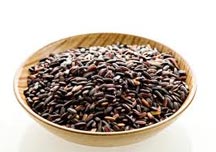 Forbidden black rice: It's prized for its fragrant aroma, nutty taste and nutritional value.
Forbidden black rice: It's prized for its fragrant aroma, nutty taste and nutritional value.
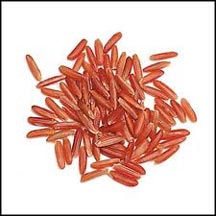 Bhutanese red rice: Grown at an elevation of 8,000 feet in the Himalayan Kingdom of Bhutan, this premium heirloom variety contains trace minerals that make for a beautiful russet color and complex, nutty flavor.
Bhutanese red rice: Grown at an elevation of 8,000 feet in the Himalayan Kingdom of Bhutan, this premium heirloom variety contains trace minerals that make for a beautiful russet color and complex, nutty flavor.
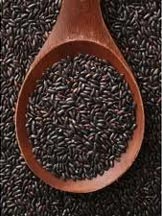 Black Japonica rice: This is actually a blend 25% black short-grain japonica and 75% medium-grain mahogany-red rice. It's chewy but tender and full of flavor, making it great for stuffing or rice salads.
Black Japonica rice: This is actually a blend 25% black short-grain japonica and 75% medium-grain mahogany-red rice. It's chewy but tender and full of flavor, making it great for stuffing or rice salads.
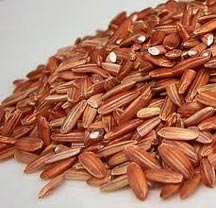 Wehani rice: This one's quite unique, with a red bran layer and an aroma not unlike hot, buttered popcorn. It's also chewy, sweet and reminiscent of brown basmati rice.
Wehani rice: This one's quite unique, with a red bran layer and an aroma not unlike hot, buttered popcorn. It's also chewy, sweet and reminiscent of brown basmati rice.

